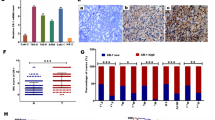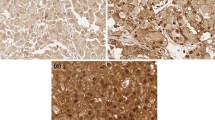Abstract
Truncated KIT (tr-KIT) is an alternative variant of c-KIT protein. Previous studies have clearly documented that c-KIT was associated with various oncogenic processes in RCC. However, the biological significance of tr-KIT in RCC development and progression remains unclear. So, it was aimed to investigate the possible association between RCC and tr-KIT which is thought to activate some oncogenic pathways. In this study, Kidney Cancer cDNA Array containing a total of 48 cDNA samples from the normal kidney tissues of 9 healthy subjects and kidney tumor tissues of 10 stage-1, 5 stage-2, 13 stage-3 and 11 stage-4 RCC patients was used for gene expression analysis. Real-Time PCR method was used to measure tr-KIT/c-KIT expression ratios. tr-KIT/c-KIT expression ratio was compared between tumor and normal samples, and statistically correlated with the clinical parameters of RCC patients. tr-KIT/c-KIT expression ratio was approximately 4-times higher in tumor samples than control ones (p = 0.001). Also, tr-KIT/c-KIT expression ratio was approximately two, three and six times higher in Fuhrman nuclear grades 2, 3 and 4 than normal, respectively (p = 0.009). Moreover, clear cell and papillary RCC has a significantly higher level of tr-KIT/c-KIT expression ratio than chromophobe RCC (p = 0.016). In the current study, it was stated for the first time that tr-KIT/c-KIT expression ratio was up-regulated in RCC tissues, and high tr-KIT/c-KIT expression ratio was correlated with more aggressive clinical features and poor patient prognosis. Our results suggest that increased tr-KIT/c-KIT expression ratio might be useful as a prognostic marker for RCC patients.




Similar content being viewed by others
References
Rönnstrand L (2004) Signal transduction via the stem cell factor receptor/c-Kit. Cell Mol Life Sci 61(19):2535–2548
Cardoso HJ, Figueira MI, Correia S, Vaz CV, Socorro S (2014) The SCF/c-KIT system in the male: survival strategies in fertility and cancer. Mol Reprod Dev 81(12):1064–1079
Figueira MI, Cardoso HJ, Correia S, Maia CJ, Socorro S (2014) Hormonal regulation of c-KIT receptor and its ligand: implications for human infertility? Prog Histochem Cytochem 49(1):1–19
Ali S, Ali S (2007) Role of c-kit/SCF in cause and treatment of gastrointestinal stromal tumors (GIST). Gene 401(1):38–45
Ashman LK, Griffith R (2013) Therapeutic targeting of c-KIT in cancer. Expert Opin Investig Drugs 22(1):103–115
Capelli L, Petracci E, Quagliuolo V, Saragoni L, Colombo P, Morgagni P, Calistri D, Tomezzoli A, Di Cosmo M, Roviello F (2016) Gastric GISTs: analysis of c-Kit, PDGFRA and BRAF mutations in relation to prognosis and clinical pathological characteristics of patients—a GIRCG study. Eur J Surg Oncol 42(8):1206–1214
Di Lorenzo G, Autorino R, D’Armiento F, Mignogna C, De Laurentiis M, De Sio M, D’Armiento M, Damiano R, Vecchio G, De Placido S (2004) Expression of proto-oncogene c-kit in high risk prostate cancer. Eur J Surg Oncol 30(9):987–992
Mitchell SG, Bunting ST, Saxe D, Olson T, Keller FG (2017) A variant c-KIT mutation, D816H, fundamental to the sequential development of an ovarian mixed germ cell tumor and systemic mastocytosis with chronic myelomonocytic leukemia. Pediatr Blood Cancer 64(4):e26282
Roskoski R (2005) Structure and regulation of Kit protein-tyrosine kinase—the stem cell factor receptor. Biochem Biophys Res Commun 338(3):1307–1315
Yarden Y, Kuang W-J, Yang-Feng T, Coussens L, Munemitsu S, Dull T, Chen E, Schlessinger J, Francke U, Ullrich A (1987) Human proto-oncogene c-kit: a new cell surface receptor tyrosine kinase for an unidentified ligand. EMBO J 6(11):3341
Cardoso HJ, Figueira MI, Socorro S (2017) The stem cell factor (SCF)/c-KIT signalling in testis and prostate cancer. J Cell Commun Signal 11:297–307
Ciccarese C, Brunelli M, Montironi R, Fiorentino M, Iacovelli R, Heng D, Tortora G, Massari F (2016) The prospect of precision therapy for renal cell carcinoma. Cancer Treat Rev 49:37–44
Parekh H, Rini BI (2015) Emerging therapeutic approaches in renal cell carcinoma. Expert Rev Anticancer Ther 15(11):1305–1314
Czarnecka AM, Kornakiewicz A, Kukwa W, Szczylik C (2014) Frontiers in clinical and molecular diagnostics and staging of metastatic clear cell renal cell carcinoma. Future Oncol 10(6):1095–1111
Cheng L, Jones TD, McCarthy RP, Eble JN, Wang M, MacLennan GT, Lopez-Beltran A, Yang XJ, Koch MO, Zhang S (2005) Molecular genetic evidence for a common clonal origin of urinary bladder small cell carcinoma and coexisting urothelial carcinoma. Am J Pathol 166(5):1533–1539
Schulz WA, Ribarska T (2011) Insights into cancer mechanisms from genomic research on urological cancers. Genome Med 3(3):20
Yang S-F, Hsu H-L, Chao T-K, Hsiao C-J, Lin Y-F, Cheng C-W (2015) Annexin A2 in renal cell carcinoma: expression, function, and prognostic significance. Urol Oncol 33(1):22.e11–22.e21
Hes O (2014) International Society of Urological Pathology (ISUP) Vancouver classification of renal neoplasia 2012. Cesk Patol 50(4):137–141
Muciaccia B, Sette C, Paronetto MP, Barchi M, Pensini S, D’agostino A, Gandini L, Geremia R, Stefanini M, Rossi P (2010) Expression of a truncated form of KIT tyrosine kinase in human spermatozoa correlates with sperm DNA integrity. Hum Reprod 25(9):2188–2202
Hsieh JJ, Purdue MP, Signoretti S, Swanton C, Albiges L, Schmidinger M, Heng DY, Larkin J, Ficarra V (2017) Renal cell carcinoma. Nat Rev Dis Primers 3:17009
Rossi P, Marziali G, Albanesi C, Charlesworth A, Geremia R, Sorrentino V (1992) A novel c-kit transcript, potentially encoding a truncated receptor, originates within a kit gene intron in mouse spermatids. Dev Biol 152(1):203–207
Sette C, Bevilacqua A, Geremia R, Rossi P (1998) Involvement of phospholipase Cγ1 in mouse egg activation induced by a truncated form of the c-kit tyrosine kinase present in spermatozoa. J Cell Biol 142(4):1063–1074
Derry JJ, Prins GS, Ray V, Tyner AL (2003) Altered localization and activity of the intracellular tyrosine kinase BRK/Sik in prostate tumor cells. Oncogene 22(27):4212–4220
Paronetto MP, Venables JP, Elliott DJ, Geremia R, Rossi P, Sette C (2003) Tr-kit promotes the formation of a multimolecular complex composed by Fyn, PLCγ1 and Sam68. Oncogene 22(54):8707–8715
Paronetto MP, Farini D, Sammarco I, Maturo G, Vespasiani G, Geremia R, Rossi P, Sette C (2004) Expression of a truncated form of the c-Kit tyrosine kinase receptor and activation of Src kinase in human prostatic cancer. Am J Pathol 164(4):1243–1251
Huang D-Y, Chao Y, Tai M-H, Yu Y-H, Lin W-W (2012) STI571 reduces TRAIL-induced apoptosis in colon cancer cells: c-Abl activation by the death receptor leads to stress kinase-dependent cell death. J Biomed Sci 19(1):35
Pinto AC, Ângelo S, Moreira JN, Simões S (2011) Schedule treatment design and quantitative in vitro evaluation of chemotherapeutic combinations for metastatic prostate cancer therapy. Cancer Chemother Pharmacol 67(2):275–284
Corcoran NM, Costello AJ (2005) Combined low-dose imatinib mesylate and paclitaxel lack synergy in an experimental model of extra-osseous hormone-refractory prostate cancer. BJU Int 96(4):640–646
Lipton A, Campbell-Baird C, Harvey H, Kim C, Demers L, Costa L (2010) Phase I trial of zoledronic acid + imatinib mesylate (Gleevec) in patients with bone metastases. Am J Clin Oncol 33(1):75–78
Mathew P, Thall PF, Jones D, Perez C, Bucana C, Troncoso P, Kim S-J, Fidler IJ, Logothetis C (2004) Platelet-derived growth factor receptor inhibitor imatinib mesylate and docetaxel: a modular phase I trial in androgen-independent prostate cancer. J Clin Oncol 22(16):3323–3329
Nabhan C, Villines D, Valdez T, Tolzien K, Lestingi T, Bitran J, Christner S, Egorin M, Beumer J (2012) Phase I study investigating the safety and feasibility of combining imatinib mesylate (Gleevec) with sorafenib in patients with refractory castration-resistant prostate cancer. Br J Cancer 107(4):592–597
Tiffany N, Wersinger E, Garzotto M, Beer T (2004) Imatinib mesylate and zoledronic acid in androgen-independent prostate cancer. Urology 63(5):934–939
Cardoso HJ, Vaz CV, Correia S, Figueira MI, Marques R, Maia CJ, Socorro S (2015) Paradoxical and contradictory effects of imatinib in two cell line models of hormone-refractory prostate cancer. Prostate 75(9):923–935
Waalkes S, Rott H, Herrmann TR, Wegener G, Kramer MW, Merseburger AS, Schrader M, Hofmann R, Kuczyk MA, Schrader AJ (2011) Does male sex influence the prognosis of patients with renal cancer? Oncol Res Treat 34(1–2):24–28
Yamazaki K, Sakamoto M, Ohta T, Kanai Y, Ohki M, Hirohashi S (2003) Overexpression of KIT in chromophobe renal cell carcinoma. Oncogene 22(6):847
Lin Z-H, Han EM, Lee ES, Kim CW, Kim HK, Kim I, Kim Y-S (2004) A distinct expression pattern and point mutation of c-kit in papillary renal cell carcinomas. Mod Pathol 17(6):611
Vuky J, Isacson C, Fotoohi M, dela Cruz J, Otero H, Picozzi V, Malpass T, Aboulafia D, Jacobs A (2006) Phase II trial of imatinib (Gleevec®) in patients with metastatic renal cell carcinoma. Investig New Drugs 24(1):85–88
Lam JS, Klatte T, Kim HL, Patard J-J, Breda A, Zisman A, Pantuck AJ, Figlin RA (2008) Prognostic factors and selection for clinical studies of patients with kidney cancer. Crit Rev Oncol Hematol 65(3):235–262
Nogueira M, Kim HL (2008) Molecular markers for predicting prognosis of renal cell carcinoma. Urol Oncol 26(2):113–124
Bui MH, Seligson D, Han K-r, Pantuck AJ, Dorey FJ, Huang Y, Horvath S, Leibovich BC, Chopra S, Liao S-Y (2003) Carbonic anhydrase IX is an independent predictor of survival in advanced renal clear cell carcinoma: implications for prognosis and therapy. Clin Cancer Res 9(2):802–811
Gilbert SM, Whitson JM, Mansukhani M, Buttyan R, Benson MC, Olsson CA, Sawczuk IS, McKiernan JM (2006) Detection of carbonic anhydrase-9 gene expression in peripheral blood cells predicts risk of disease recurrence in patients with renal cortical tumors. Urology 67(5):942–945
Zigeuner R, Ratschek M, Rehak P, Schips L, Langner C (2004) Value of p53 as a prognostic marker in histologic subtypes of renal cell carcinoma: a systematic analysis of primary and metastatic tumor tissue. Urology 63(4):651–655
Kim HL, Seligson D, Liu X, Janzen N, Bui MH, Yu H, Shi T, Belldegrun AS, Horvath S, Figlin RA (2005) Using tumor markers to predict the survival of patients with metastatic renal cell carcinoma. J Urol 173(5):1496–1501
Kim HL, Seligson D, Liu X, Janzen N, Bui MH, Yu H, Shi T, Figlin RA, Horvath S, Belldegrun AS (2004) Using protein expressions to predict survival in clear cell renal carcinoma. Clin Cancer Res 10(16):5464–5471
Klatte T, Seligson DB, Leppert JT, Riggs SB, Yu H, Zomorodian N, Kabbinavar FF, Strieter RM, Belldegrun AS, Pantuck AJ (2008) The chemokine receptor CXCR45 is an independent prognostic factor in patients with localized clear cell renal cell carcinoma. J Urol 179(1):61–66
Cheville JC, Lohse CM, Zincke H, Weaver AL, Blute ML (2003) Comparisons of outcome and prognostic features among histologic subtypes of renal cell carcinoma. Am J Surg Pathol 27(5):612–624
Patard J-J, Leray E, Rioux-Leclercq N, Cindolo L, Ficarra V, Zisman A, De La Taille A, Tostain J, Artibani W, Abbou CC (2005) Prognostic value of histologic subtypes in renal cell carcinoma: a multicenter experience. J Clin Oncol 23(12):2763–2771
Kattan MW, Reuter V, Motzer RJ, Katz J, Russo P (2001) A postoperative prognostic nomogram for renal cell carcinoma. J Urol 166(1):63–67
Zimpfer A, Janke S, Hühns M, Schneider B, Kundt G, Zettl H, Kilic E, Maruschke M, Hakenberg OW, Erbersdobler A (2014) C-kit overexpression is not associated with KIT gene mutations in chromophobe renal cell carcinoma or renal oncocytoma. Pathol Res Pract 210(8):521–525
Acknowledgements
This study was funded by The Scientific & Technological Research Council of Turkey (TUBITAK) (Grant No: 118S162).
Author information
Authors and Affiliations
Corresponding author
Ethics declarations
Conflict of interest
All authors of original research article declare that they have no conflict of interest.
Additional information
Publisher's Note
Springer Nature remains neutral with regard to jurisdictional claims in published maps and institutional affiliations.
Rights and permissions
About this article
Cite this article
Ergün, S., Altay, D.U., Güneş, S. et al. Tr-KIT/c-KIT ratio in renal cell carcinoma. Mol Biol Rep 46, 5287–5294 (2019). https://doi.org/10.1007/s11033-019-04985-3
Received:
Accepted:
Published:
Issue Date:
DOI: https://doi.org/10.1007/s11033-019-04985-3




